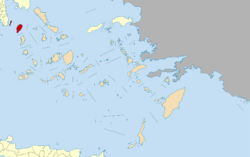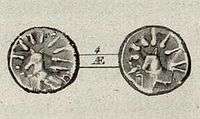Kea (island)
| Kea Κέα | |
|---|---|
|
Kea Island | |
 Kea | |
|
Location within the region  | |
| Coordinates: 37°37′N 24°20′E / 37.617°N 24.333°ECoordinates: 37°37′N 24°20′E / 37.617°N 24.333°E | |
| Country | Greece |
| Administrative region | South Aegean |
| Regional unit | Kea-Kythnos |
| Area | |
| • Municipality | 128.9 km2 (49.8 sq mi) |
| Highest elevation | 560 m (1,840 ft) |
| Lowest elevation | 0 m (0 ft) |
| Population (2011)[1] | |
| • Municipality | 2,455 |
| • Municipality density | 19/km2 (49/sq mi) |
| Community | |
| Time zone | EET (UTC+2) |
| • Summer (DST) | EEST (UTC+3) |
| Postal code | 840 02 |
| Area code(s) | 22880 |
| Vehicle registration | ΕΜ |
| Website | www.kea.gr |
Kea (Greek: Κέα), also known as Gia or Tzia (Greek: Τζια), Zea, and, in antiquity, Keos (Greek: Κέως, Latin: Ceos), is a Greek island in the Cyclades archipelago in the Aegean Sea. Kea is part of the Kea-Kythnos regional unit.
Geography
It is the island of the Cyclades complex that is closest to Attica (about 1 hour by ferry from Lavrio) and is also 20 km (12 mi) from Cape Sounio as well as 60 km (37 mi) SE of Athens. Its climate is arid, and its terrain is hilly. Kea is 19 km (12 mi) long from north to south and 9 km (6 mi) wide from west to east. The area is 129 km2 (50 sq mi) with the highest point being 560 m (1,837 ft) above sea level
Its capital, Ioulis, is inland at a high altitude (like most ancient Cycladic settlements, for fear of pirates) and is considered quite picturesque. Other major villages of Kea are the port of Korissia and the fishing village of Vourkari. After suffering depopulation for many decades, Kea has been recently rediscovered by Athens as a convenient destination for weekends and yachting trips. The population in 2011 was 2,455.
The municipality Kea also includes the island of Makronisos to the northwest.
Local Communities
- Chavouna
- Ellinika Kea
- Kato Meria
- Ioulis
- Kea
- Korissia
- Koundouros, Greece
- Otzias
- Pisses
- Vourkari
History

_beach.jpg)
Kea is the location of a bronze-aged settlement at the site now called Ayia Irini, which reached its height in the Late Minoan and Early Mycenaean eras (1600-1400 BCE).
In the Archaic period, the island was divided between four city-states (poleis): Ioulis, Karthaia, Poieessa and Koressos.
During the classical period, Kea (Ceos) was the home of Simonides and of his nephew Bacchylides, both ancient Greek lyric poets, of the Sophist Prodicus, and of the physician Erasistratus. The inhabitants were known for offering sacrifices to the Dog Star, Sirius and to Zeus to bring cooling breezes while awaiting for the reappearance of Sirius in summer; if the star rose clear, it would portend good fortune; if it was misty or faint, then it foretold (or emanated) pestilence. Coins retrieved from the island from the 3rd century BC feature dogs or stars with emanating rays, highlighting Sirius' importance.[2]
During the Byzantine period, many churches were built and the prosperity of the island rose. It was Byzantine until, in 1204, it was captured by the Venetians in the wake of the Fourth Crusade. The Archbishop of Athens, Michael Choniates, came here in exile after his city fell to the Crusaders in 1205. It was recaptured by the Byzantines under Licario in 1278. In ca. 1302 during the Byzantine–Venetian War, it fell to the Venetians again, who built a castle on the ancient acropolis of Ioulis.
Kea was taken from the Venetians by the Ottoman Turks in 1537. Along with the rest of the Cyclades, Kea joined Greece following the Greek War of Independence in 1821.
HMHS Britannic, the largest ship sunk in World War I, which was the sister ship to the RMS Titanic and the RMS Olympic, sank off Kea island in 1916.
Ecclesiastical History
Orthodox Eparchy
The earliest indication of it as a Greek bishopric is in a list by the Sicilian monk Nil Doxapatris of the second half of the 12th century and this may have been a later interpolation, since the list of the Greek bishops of Kea begins only at the end of the 16th century.[3][4][5]
Latin Catholic residential diocese
In 1330, as part of the Venetian Duchy of Naxos, it became, under the name Ceo, the see of a Latin Church bishopric of Ceo in the Cyclades, which in 1600 was renamed bishopric of Thermia (island Knythos), but suppressed in 1650, after the Ottoman conquest.
It has had the following residential Latin bishops :
- Suffragan Bishops of Ceo
- Nicolò (? – ?)
- Pietro, Dominican Order (O.P.) (1350.11.17 – ?)
- Princivalle, Friars Minor (O.F.M.) (1370.05.29 – ?)
- Simone da Arezzo, O.F.M. (1376.06.16 – ?)
- Giorgio (? – ?)
- Francesco da Venezia, O.F.M. (1422.07.06 – ?)
- Francesco Barberi (1435? – death 1445?)
- Francesco, O.F.M. (1445.06.09 – 1453.04.30), later Bishop of Naxos (Greek island) (1453.04.30 – ?)
- Giovanni di Sicilia, O.F.M. (1454.11.29 – ?)
- Nicolò (? – ?)
- Pietro (? – ?)
- Gómez (1498.05.24 – ?)
- Giorgio Barozzi (? – ?)
- Giovanni Zotto (1520.02.06 – ?)
- Dionisio Zannettini, O.F.M. (1529.02.08 – 1538.12.11), later Bishop of Milopotamus (also in Greece; 1538.12.11 – 1555)
- Costantino Giustianiani, O.P. (1540.08.27 – death 1546)
- Giovanni de Gaona, Canons Regular of saint Augustine (C.R.S.A.) (1546.02.19 – ?)
- Giacomo Rocca (1550? – ?)
- Suffragan Bishops of Thermia
- Pietro Pitarca, Order of the Minims (O.M.) (1617.06.26 – ?)
- Cristoforo Carletti, O.M. (1622.05.29 – 1625)
- Giacomo della Rocca (1634.09.25 – ?)
- Giovanni Camponeschi (1644.12.19 – 1654), later Bishop of Mottola (in Italy; 1654.06.22 – 1657.11)
Latin Catholic titular see of Cea
It is today listed by the Catholic Church as a titular see.[6]
Since the diocese's nominal restoration in 1933, under the name Cea, it has had the following incumbents, of the lowest (episcopal) rank, but is vacant since decades :
- Bishop James Thomas O’Dowd (1948.05.22 – 1950.02.05)
- José Clemente Maurer, Redemptorists (C.SS.R.) (1950.03.01 – 1951.10.27), as Auxiliary Bishop of La Paz (Bolivia) (1950.03.01 – 1951.10.27), later Metropolitan Archbishop of Sucre (Bolivia) (1951.10.27 – 1983.11.30), created Cardinal-Priest of SS. Redentore e S. Alfonso in Via Merulana (1967.06.29 – 1990.06.27), President of Episcopal Conference of Bolivia (1968 – 1979)
- Fr. Wesceslau Nazareno Ponte de Spoleto, Capuchin Friars (O.F.M. Cap.) (1952.04.26 – 1952.06.29)
- Bishop Lawrence Bernard Brennan Casey (1953.02.10 – 1966.03.04)
Historical population
| Year | Island population |
|---|---|
| 1991 | 1,797 |
| 2001 | 2,417 |
| 2011 | 2,455 |
Notable people
- Aristo (3rd century BC) Peripatetic philosopher
- Prodicus (5th century BC) sophist
- Simonides lyric poet (c. 556 BC-468 BC)
- Bacchylides ( 5th century BC) lyric poet
- Patriarch Meletius III of Constantinople
- Cyparissos Stephanos, mathematician
See also
Scuba diving
The island is famous for scuba diving with excellent visibility, rich marine life, awesome wall, cavern and wreck diving. Water temperature from 20-26 degrees Celsius. The highlight for recreational divers is the wreck of the unique paddle/wheeler steamship Patris which sank in 1868. She was a passenger steamer with length of 217 feet, in service in the Aegean Sea, owned by the "HELLENIC STEAMSHIP Co." based on Syros island, at that time the capital of Greece. She hit the reef off Koundouros Bay at Makriopounda, Kea island on the 24th February 1868 with about 120 passengers aboard. No casualties were reported owing to the proximity of land. She lays in -28m [7] The world famous wreck of the HMHS Britannic, sister ship of the Titanic, located 1.5 nautical mile offshore, is for Tec divers, as the depth is approx. 120 metres (394 feet). SS Burdigala is a recently discovered wreck, 800 metres (2,625 feet) from the island's harbour, in -53m depth. For experienced divers only. Sunk in 1916, a 180 meters long ocean liner built in Germany by Blohm & Voss [8]
References
- ↑ "Απογραφή Πληθυσμού - Κατοικιών 2011. ΜΟΝΙΜΟΣ Πληθυσμός" (in Greek). Hellenic Statistical Authority.
- ↑ Holberg, JB (2007). Sirius:Brightest Diamond in the Night Sky. Chichester, UK: Praxis Publishing. p. 20. ISBN 0-387-48941-X.
- ↑ Raymond Janin, v. Céos, in Dictionnaire d'Histoire et de Géographie ecclésiastiques, vol. XII, Parigi 1953, coll. 147-148
- ↑ Vitalien Laurent, v. Cythnos, in Dictionnaire d'Histoire et de Géographie ecclésiastiques, vol. XIII, Parigi 1956, coll. 1190-1191
- ↑ Pius Bonifacius Gams, Series episcoporum Ecclesiae Catholicae, Leipzig 1931, p. 449
- ↑ Annuario Pontificio 2013 (Libreria Editrice Vaticana 2013 ISBN 978-88-209-9070-1), p. 863
- ↑ http://www.wrecksite.eu/wreck.aspx?123766
- ↑ http://www.wrecksite.eu/wreck.aspx?138084
Sources and External links
| Wikimedia Commons has media related to: |
- Official Island website
- GigaCatholic, with incumbent biography links
- An 1885 travel guide to Keos (Zea), an excerpt from James Theodore Bent's The Cyclades, or Life among the Insular Greeks
| ||||||||||
| ||||||||||||||||||||||||||||||||||||||||||||||||||||||||||||||||||
| ||||||
|

